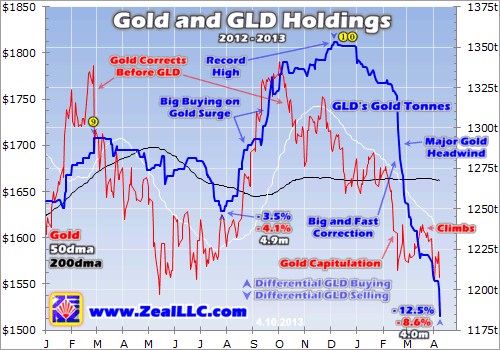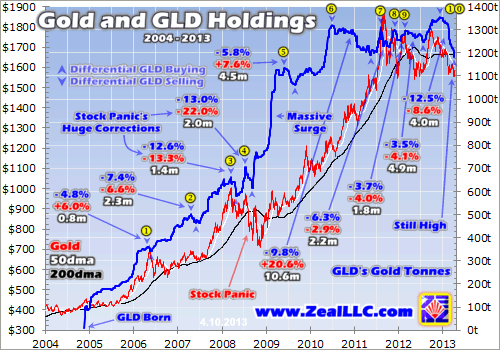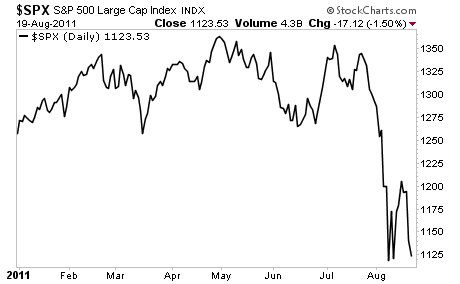Gold has faced stiff headwinds lately as investors abandon
alternative investments to chase record-high stock markets. Probably
the most significant has been the major selling hammering the flagship
GLD gold ETF. It has suffered such intense differential selling
pressure that its custodians have been forced to dump enormous
quantities of physical gold. What are the implications of this flood
of new supply?
The amount of gold bullion GLD has hemorrhaged recently is amazing.
To put it into perspective, earlier this week the rumor that embattled
Cyprus may be forced to sell its official gold reserves made news.
The Cypriot government owns 13.9 metric tons of gold. But on a single
trading day alone in February’s gold capitulation, GLD had to sell 20.8
tonnes! The supply recently added by GLD dwarfs everything else.
Why is GLD dumping gold so aggressively? While silly conspiracy
theories abound as always in the gold world, the reality is far less
provocative. GLD’s mission is simply to track the price of gold. The
World Gold Council (which is funded by leading gold miners) created
this gold investment vehicle in November 2004 to offer stock investors
an easy, cheap, and efficient way to obtain gold exposure in their
portfolios.
The gold miners created a direct conduit for the vast pools of
stock-market capital to chase gold. The only way for GLD to fulfill
its mission of tracking gold is for this ETF to shunt excess GLD-share
demand and supply into underlying physical gold bullion itself. This
capital sloshing into and out of gold via GLD has naturally had a
massive impact on global gold prices. And lately gold has suffered a
major GLD exodus.
During times like 2009 when gold grows popular among investors, GLD
shares are bought up far faster than gold itself is rallying. This
excess, or differential, GLD demand would quickly force this ETF to
decouple from the metal to the upside if not equalized into physical
gold. So GLD’s custodians sop it up by issuing new GLD shares to meet
demand. They then use the proceeds to buy more gold bullion.
But when gold is falling out of favor like now, capital flows
reverse. GLD shares are dumped at a quicker pace than gold’s own
selloff. This differential selling pressure creates an excess supply
of GLD shares. This ETF would decouple from gold to the downside if
this wasn’t equalized into the metal. So GLD is forced to buy up this
excess supply. It raises the cash to do this by selling some of its
gold bullion.
And this is what we’ve experienced lately, heavy differential selling
pressure. As the levitating stock markets rise ever higher,
investors have sold gold to buy general stocks. Because of its
incredible liquidity, GLD has been the epicenter of this
anti-alternative-investment rotation. It’s rather illogical when you
think about it, selling gold low to buy stocks high. Investors are
supposed to buy low and sell high!
But sadly greed and fear always overwhelm reason at market
extremes. Foolish investors rush to sell low after long corrections,
just before new uplegs are born. And later they eagerly flood into
markets after long uplegs, buying high just before major corrections.
Selling low and buying high leads to financial ruin, which is why such a
small fraction of investors ever achieve significant success in the
financial markets.
Gold is universally despised right now because it is low, the ideal
time to buy. General stocks are adored if not worshipped because they
are high, the prudent time to sell. Every day on CNBC, a long parade of
analysts effectively proclaim gold is doomed to sink to zero while
stocks will joyously rally forever more. The intense selling pressure
GLD has faced in recent months simply reflects these emotional
extremes.
As a contrarian I’ve grown rich fighting the crowd, being brave when
others are afraid and afraid when others are brave as Warren Buffett
once eloquently put it. That’s the only way to buy low and sell
high. So I’ve watched GLD’s holdings lately with great interest.
Thankfully this flagship gold ETF is very transparent, publishing its
holdings daily. How does GLD’s holdings plunge stack up relative to
precedent?
This first chart over the past year or so highlights the extreme
differential selling pressure GLD has faced in recent months. Its
holdings are shown in blue and tied to the right axis, superimposed
over the gold price in red. There has been no bigger headwind facing
gold lately than the deluge of physical-gold-bullion supply GLD has
been forced to dump into the global gold markets. It has proven
overwhelming.

Remember Cyprus’s 13.9t of official gold reserves? The recent
“correction” in GLD’s holdings has forced it to dump a staggering
169.8t of gold bullion simply to keep GLD shares’ price tracking gold!
We are talking about 5.5m ounces of gold here, from this single
American ETF! There are only two gold-mining companies in the entire
world (Barrick and Newmont) that produce that much gold in a whole
year!
Yet the mass exodus from GLD by stock investors forced it to add
169.8t of gold supply in just over 4 months. It’s hard to believe given
how despised gold is today, but back on December 7th GLD’s holdings
hit an all-time record high of 1353.4t. They remained stable and held
near this record for several weeks, until two simultaneous events hit
in early January that started cracking gold’s bullish sentiment.
First the flagship S&P 500 stock index soared 2.5% on January’s
opening trading day on news of the fiscal-cliff tax deal. The biggest
tax hike in US history had been narrowly averted at the very last
minute. And then the very next day, the minutes from the recent FOMC
meeting were misinterpreted to imply the Fed was already preparing to
shut off its brand-new QE3 debt-monetization campaign. So gold sold
off.
Ever since 2013’s fateful initial trading days, those psychological
cracks plaguing gold have spread. Every day that the stock markets’
levitation continued, gold fell farther out of favor among investors.
And then every few weeks there was either an FOMC meeting or the
minutes from one to spook traders into somehow assuming the Fed’s
unprecedented open-ended inflation campaign would end prematurely.
The resulting heavy differential selling pressure on GLD shares is
readily apparent above. This peaked in late February just after gold
selling cascaded into a
full-blown capitulation.
In just 7 trading days late that month, GLD’s custodians were forced
to sell 5.0% of its holdings (65.5t) to buy back enough excess share
supply to keep this ETF from decoupling from gold. Like many market
extremes, this became self-feeding.
As GLD dumped bullion to raise enough cash to buy back the flood of
excess shares being sold, those very gold sales weighed on global gold
prices. This caused more gold stops to be triggered, and kindled more
fear, scaring still more traders into exiting. The lower gold went,
the more people sold, and the more this selling forced GLD to add big
supplies to a very weak gold market. It was a relentless vicious
circle.
As of this past Wednesday, GLD’s holdings had fallen a mind-boggling
12.5% in just over 4 months! It has had to liquidate 1/8th of its
total gold bullion to keep up with stock traders rushing for the gold
exits. Over this same span, the gold price is down 8.6%. Since
rising and falling GLD holdings reveal whether stock traders are buying
or selling gold on balance, I’ve closely followed them daily since
GLD’s birth.
GLD holdings trends are one of the best gold sentiment indicators available. And provocatively they’ve long proven
rather “sticky”.
While stock traders eagerly buy up GLD shares when gold is rallying
and in favor, they have generally not sold too aggressively when gold
was correcting. So the sheer degree of the recent GLD holdings plunge
sure felt exceptional. I’ve been wondering if it was the biggest ever.
So this week I decided to look at all the GLD holdings “corrections”
over this ETF’s entire history. And I was pleasantly surprised to find
out that we’ve weathered worse. Coming off record highs, the recent
169.8t GLD dump is certainly the biggest absolute decline in its
holdings. But in percentage terms, GLD’s holdings suffered even bigger
retreats as gold fell deeply out of favor during 2008’s crazy stock
panic.

My suspicion that the recent GLD holdings plunge was exceptional was
generally correct. Outside of that once-in-a-century stock panic,
GLD’s average holdings correction has merely been 5.9% over 3.9
months. So while the recent holdings correction’s 4.0-month duration
is on par, its 12.5% slide more than doubled what has been typically
witnessed for the vast majority of GLD’s lifespan. It was indeed very
big.
The only comparable declines were leading into and during 2008’s
stock panic, when GLD’s holdings plunged 12.6% over 1.4 months and
later another 13.0% over 2.0 months. It is interesting that these were
the worst GLD selloffs ever seen, and they happened in far-worse gold
conditions.
While gold is merely down 8.6% during the recent GLD
holdings correction, it plunged by 13.3% and 22.0% during 2008’s!
The latter is particularly interesting and relevant today. If there
was ever a time for gold to shine as a safe haven, it was during that
epic stock panic. In a single month in October 2008, the flagship
S&P 500 stock index plummeted 30.0%! Fear was off the charts,
with the definitive VXO fear gauge challenging 90 when only around 50
is normally the worst-case extreme. The financial world was crumbling
right before our eyes.
Yet gold couldn’t catch a bid! Its price plunged 16.7% over that
month-long span where the stock markets lost nearly a third of their
value. Stock investors deployed in GLD rushed to sell their shares,
both disgusted by gold’s failure to surge on a financial Apocalypse and
trying to raise cash wherever they could. Between July and November
2008, gold fell an astounding 27.2%. It was truly a total disaster.
The main reason gold plummeted during that panic is because safe-haven buying flooded
into the US dollar
instead, driving its biggest and fastest rally (22.6% higher in 4
months) ever witnessed. But the key takeaway today is that the
financial world was totally convinced gold was dead. If it couldn’t
rally in that panic, then it was no longer a safe haven. There was no
reason to own gold anymore, its bull was over.
Sound familiar? That’s the exact kind of thing we’ve been hearing
in recent weeks. Because gold hasn’t rallied despite the Cyprus bank
failures and record Fed debt monetizations, there must be something
fundamentally wrong with this metal. Traders are abandoning it in
droves, just like they did in late 2008.
But obviously they were dead
wrong to sell low then when gold was hated. It was on the cusp of
soaring.
Right as investors totally capitulated and gave up on gold in
November 2008, it was carving a major bottom. It would ultimately power
from around $700 then to $1900 by August 2011. And ever since it has
consolidated high, it is simply at the low end of its multi-year
trading range today. A major gold correction driving or being driven
by a massive 1/8th GLD holdings selloff was the best buy signal of
gold’s bull!
I suspect the recent 1/8th GLD holdings correction will prove
similarly bullish. In order for stock traders to dump GLD shares
rapidly enough to force it to sell so much bullion so fast, their
sentiment has to be hyper-bearish. They have to be utterly convinced
gold’s bull is dead to sell so aggressively.
But whenever sentiment
swings to such unsustainable extremes, major bottoms are carved leading
into major uplegs.Extreme GLD selling on a daily basis is also a fantastic contrarian
indicator itself. I generally consider GLD differential selling
pressure on any given day material if it is big enough to force GLD’s
holdings down by more than 0.5% that day alone. And big GLD holdings
liquidation days are over 1.0%. Clusters of these near gold lows are
major bottoming indicators, they reveal sentiment in gold has grown too
bearish to persist.
Since the February gold capitulation, we’ve seen 3 separate trading
days where GLD’s holdings fell more than 1.0%. They are pretty rare
over GLD’s 8.4-year history, only occurring 51 times or about once
every 40 trading days. The last time a similar cluster was seen was
actually in October 2008 during the stock panic, just before gold
started more than doubling in its next mighty upleg that was being born
in despair.
So historically big GLD liquidations, both in individual-trading-day
and multi-month-trend terms, have actually been very bullish
contrarian indicators. This precedent completely contradicts many of
the gold bears dominating the financial media, who claim excessive GLD
selling is bearish rather than bullish. In reality, stock traders
panicking out of GLD shares is an indicator of fear reaching irrational
extremes.
So smart contrarians fight the crowd and aggressively buy GLD
holdings plunges. The only way to buy low is to be brave when others
are afraid, and they are certainly afraid of gold today. Bearishness
in this yellow metal has recently hit extremes not seen since the stock
panic, the best gold buying opportunity of its secular bull. The
recent GLD holdings liquidation was also panic-magnitude, utterly
unsustainable.
Stock investors have been fleeing GLD, selling low, so they can plow
their capital into general stocks near nominal record highs. The
red-hot stock markets have fueled the dismal sentiment in alternative
investments like gold. But as soon as they decisively turn, which
ought to be imminent given how overbought and euphoric the stock markets
are today, the precious metals will start returning to favor.
The same unsustainable hyper-bearish sentiment forcing the massive
GLD liquidation in recent months is crushing the gold miners’ stocks.
They are hyper-oversold, trading at their lowest valuations of their
entire secular bull. The main gold-stock index is scraping
fundamentally-absurd 45-month lows, trading as if gold and silver were
41% and 53% lower than today’s levels! The gold-stock sector is
loathed today.
Which makes it an extraordinary contrarian buying opportunity! At
Zeal we’ve been concentrating our buying around this major gold bottom
in smaller dirt-cheap gold and silver miners with dazzling
fundamentals. As sentiment inevitably turns in gold, the entire
precious-metals realm is going to soar but the best of the miners ought
to skyrocket. We are talking about stock prices tripling or
quadrupling!
So if you have cultivated the mental toughness to buy low when few
others dare, gold stocks are the place to be today. We are constantly
researching that entire universe to uncover the most
fundamentally-promising miners. Last month we published a popular new
31-page fundamental report profiling our dozen favorite junior gold
producers in depth.
Buy it today, buy some great gold stocks cheap, and thank us later!
We also publish acclaimed weekly and monthly subscription
newsletters long loved by speculators and investors worldwide. In them I
draw on our vast experience, wisdom, knowledge, and ongoing research
to explain what is going on in the markets, why, where they are likely
headed, and how to trade them. Our contrarian approach works, the 637
stock trades recommended in our newsletters since 2001 have averaged
stellar annualized realized gains of +33.9%!
Subscribe today!
The bottom line is stock investors have indeed been panicking out of
GLD in recent months. This extreme bearishness has created a
panic-grade drawdown in GLD’s holdings. All this excess gold supply
from GLD’s forced selling has been a major headwind for gold,
exacerbating its latest correction. But historically extreme GLD
selling by stock traders is a major bottoming indicator for the yellow
metal.
Like everything else in the markets, gold bottoms and embarks on
major new uplegs when everyone is convinced it is dead. Widespread
fear soon leads to selling exhaustion, leaving only buyers. So gold
soon starts rallying again, gaining momentum. This coming upleg has the
potential to be very large as the euphoric, overbought, levitating
stock markets inevitably reverse. Alternatives will quickly regain
favor.
Adam Hamilton, CPA
Source 





![[Most Recent USD from www.kitco.com]](http://www.weblinks247.com/indexes/idx24_usd_en_2.gif)




